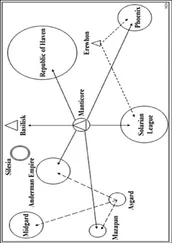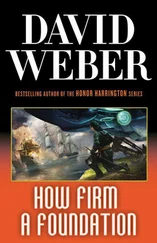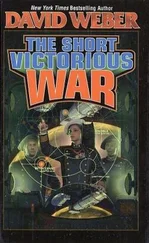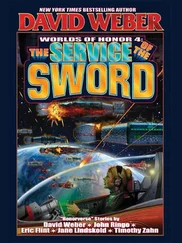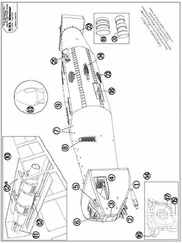David Weber - Ashes of Victory
Здесь есть возможность читать онлайн «David Weber - Ashes of Victory» весь текст электронной книги совершенно бесплатно (целиком полную версию без сокращений). В некоторых случаях можно слушать аудио, скачать через торрент в формате fb2 и присутствует краткое содержание. ISBN: , Издательство: Baen Publishing Enterprises, Жанр: Фантастика и фэнтези, на английском языке. Описание произведения, (предисловие) а так же отзывы посетителей доступны на портале библиотеки ЛибКат.
- Название:Ashes of Victory
- Автор:
- Издательство:Baen Publishing Enterprises
- Жанр:
- Год:неизвестен
- ISBN:0-671-31977-9
- Рейтинг книги:4 / 5. Голосов: 1
-
Избранное:Добавить в избранное
- Отзывы:
-
Ваша оценка:
- 80
- 1
- 2
- 3
- 4
- 5
Ashes of Victory: краткое содержание, описание и аннотация
Предлагаем к чтению аннотацию, описание, краткое содержание или предисловие (зависит от того, что написал сам автор книги «Ashes of Victory»). Если вы не нашли необходимую информацию о книге — напишите в комментариях, мы постараемся отыскать её.
Ashes of Victory — читать онлайн бесплатно полную книгу (весь текст) целиком
Ниже представлен текст книги, разбитый по страницам. Система сохранения места последней прочитанной страницы, позволяет с удобством читать онлайн бесплатно книгу «Ashes of Victory», без необходимости каждый раз заново искать на чём Вы остановились. Поставьте закладку, и сможете в любой момент перейти на страницу, на которой закончили чтение.
Интервал:
Закладка:
Of course the LAC crews were a bit less formal in the unofficial names they assigned their ships. In Hydra One 's case, Harkness' bid to immortalize his wife, Sergeant-Major Iris Babcock, by naming the vessel the Iris B had come to naught—not without vigorous campaigning and a certain degree of somewhat threatening moral persuasion on his part. Instead, Ensign Audrey Pyne's nomination had carried the day. Ensign Pyne, Tremaine's tac officer, was a bit of a romantic and a pronounced history nut, and she'd dug back into Old Terran history in search of ancient parallels to her new duty slot. Like Jackie Harmon, she'd found inspiration in the fragile, old-fashioned, downright quaint pure air-breathers of the last two centuries Ante Diaspora, and it was largely thanks to her efforts that the Nineteenth Wing had begun a new tradition, already spreading to the other wings (with Admiral Truman's support, despite the disapproval of certain other senior officers), of embellishing their LACs with distinctive "nose art." She was also something of an optimist, and her crewmates had decided her suggested name— Bad Penny —carried hopeful connotations which certainly ought to be encouraged. Lieutenant Commander Roden's crew, on the other hand, had opted for the rather more colorful suggestion of its engineer, PO 1/c Bolgeo, and decided to go with Cutthroat .
At the moment, however, what mattered more than the internal organization of the RMN's LAC force was what Roden and Bolgeo had come up with.
The original Shrike -class LACs had suffered from the fact that they were still an experimental design. The concept's basic soundness had been demonstrated conclusively at Second Hancock, but it would have been remarkable if their first battle hadn't demonstrated a certain number of flaws in the initial execution.
The worst weakness had been the absence of any after-point defense. The ability of the new LACs' missiles to accept radically off-bore firing solutions theoretically let countermissiles fired from their bow-mounted launchers cover most of their rear threat arc. But only in theory, because the designers had been overconfident. They had assumed that Shrikes would be such elusive targets that "overs" would be unable to attack from astern, and, in order to save mass and internal volume, they'd included no countermissile control links to guide long-range intercepts, and CM sensors were too myopic to do the job without the links. That had been bad enough, but even worse, perhaps, they had also failed to provide aft-firing laser clusters for close-in defense... and their assumptions had proven far too optimistic. Most of the Shrikes lost at Second Hancock had, in fact, been killed by "up-the-kilt" laser head snap shots at close range—exactly the sort of attack the designers had believed would be impossible. But while the firing solutions for that sort of attack against something as small and agile as a Shrike were, indeed, difficult to generate, the odds of success were much better than prebattle analyses had projected, and it took only a single one of them to kill an LAC.
BuWeaps' and BuShips' response had been the Shrike-B , which exchanged the original Shrike 's internal hangar for its own small cutter/lifeboat for four more countermissile launchers, a half dozen fire control links, and six more laser clusters designed to cover its stern. In addition, total countermissile magazine space had risen from fifty-two to one hundred, evenly divided fore and aft. Unlike larger, hyper-capable ships, the Shrike-B s lacked transfer tubes, so each point defense battery had its own magazine, and the forward launchers could not use the after-launchers' birds or vice versa. That was a fairly minor concern, however, and all of the sims (whose parameters had been heavily updated on the basis of actual combat experience at Hancock) indicated that the new LACs would be considerably more survivable than the original Shrike .
In addition, however, Vice Admiral Adcock's BuWeaps was finally getting the entire Ghost Rider missile and drone family into full production. Because Ghost Rider's components had initially been conceived of as something to be carried only by hyper-capable combatants, BuWeaps had faced a severe challenge in engineering the same capabilities into something a LAC could carry, but they'd met it. The LAC-sized specialist missiles and drones were less capable than the full-sized versions, but the LACs were also far harder for enemy fire control to lock up in the first place, so the trade-off in effectiveness was virtually a dead heat. Where the LACs came up shortest was that they didn't have much internal capacity for any missiles, and each electronic warfare bird they carried was one less shipkiller they could have fitted in.
BuShips' solution, designed in close cooperation with BuWeaps, was the Ferret -class LAC. The Ferrets dropped all offensive energy armament to provide the maximum hull volume for missile magazines and an even more powerful electronic warfare suite. The enormous squeeze the Shrikes' massive graser put on their internal volume was obvious when the missile numbers on the Shrike-B— twenty shipkillers and a hundred countermissiles—were compared to the same numbers for the Ferret: fifty-six shipkillers and no less than one hundred and fifty countermissiles. That was particularly impressive given that EW volume requirements had grown by over twelve percent at the same time.
Doctrine called for the Ferrets to operate in a support role for the Shrike-Bs in alpha strikes on heavy warships. Against light combatants or merchantmen, the Ferret would be lethal from well outside the Shrike-B 's energy-attack range, but LAC-sized missiles would be much less effective against anything bigger than a heavy cruiser. Against heavy units, the Ferret 's job was to accompany the Shrike-B to provide EW support and as an antimissile escort, relying on its heavy countermissile load for active intercepts, and with its main magazines stuffed with electronic warfare birds rather than with shipkillers. Each LAC wing was assigned two squadrons of the missile boats, and despite a certain initial skepticism, the "Bird Boats" of the missile squadrons had quickly earned the respect of anyone who exercised with them. Or against them.
But the Ferrets also had one more innovation which the Shrike-Bs lacked. Because they had no offensive energy armament, it would have been foolish for them to accompany the graser-armed LACs all the way in on an alpha strike, so doctrine called for them to break off before the strike entered the enemy's point-blank energy range. That protected them from the fury of heavy shipboard lasers and grasers to which they could not reply, but it also meant enemy missiles were far more likely to get a clean shot at their after-aspects as they broke off and away. Accordingly, BuShips had used the last scraps of the internal volume freed by removing the graser to shoehorn in an additional sidewall generator. Just as powerful as the new "bow-wall" that closed off and protected the front of a Shrike' s wedge as it bored into energy range, the Ferret 's "sternwall" closed off the rear of the wedge. Power requirements and the physics of the wedge meant only one aspect, bow or stern, could be closed at any given moment, but it gave a Ferret 's skipper a much more flexible choice of breakaway vectors.
What Roden and Bolgeo wanted to do was build the same capability into a Shrike-B. BuShips had already considered the possibility and pronounced against it because the designers had no more internal volume to work with. They couldn't put the additional generator in without taking something else out , and they were disinclined to start pulling the additional systems BuWeaps had just bullied them into putting in in the first place.
Читать дальшеИнтервал:
Закладка:
Похожие книги на «Ashes of Victory»
Представляем Вашему вниманию похожие книги на «Ashes of Victory» списком для выбора. Мы отобрали схожую по названию и смыслу литературу в надежде предоставить читателям больше вариантов отыскать новые, интересные, ещё непрочитанные произведения.
Обсуждение, отзывы о книге «Ashes of Victory» и просто собственные мнения читателей. Оставьте ваши комментарии, напишите, что Вы думаете о произведении, его смысле или главных героях. Укажите что конкретно понравилось, а что нет, и почему Вы так считаете.


